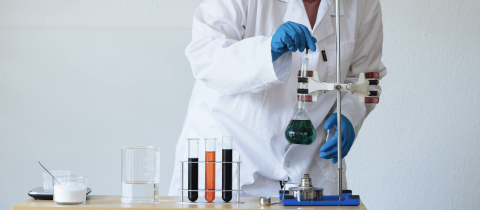Nobody looks forward to cleaning toilets. And maybe in the future you won’t have to. That may be one of the benefits of nanotechnology, a burgeoning field of science that everyone is talking about. “Nano” comes from the Greek meaning dwarf, and nano is small indeed. A nanometer is one billionth of a meter. To put this into perspective, the width of a human hair is at least 10,000 nanometers. So on a nano scale, the diameter of a hair is positively gigantic. Nanotechnology deals with substances that are less than 100 nanometers in size. And on this scale, the properties of substances can differ dramatically from what they may exhibit on a larger scale. Take titanium dioxide, for example.
You may have heard of titanium dioxide in various connections. Tiny crystals of this stuff make white paint white and can also be incorporated into suntan lotions to reflect ultraviolet light. But they have another property as well. Titanium dioxide crystals can act as photocatalysts. When light strikes them, electrons are dislodged, and these in turn react with moisture in the air and with oxygen to form hydroxyl and superoxide free radicals. Now that sounds complicated. But all we have to understand is that these free radicals are highly reactive and will attack and destroy organic molecules. Like the molecules that make up stains, smells or those that are critical to the life of bacteria. The smaller the particle size, the more adept the titanium dioxide crystals are at acting as photocatalysts.
Now we can get back to our toilet problem. Incorporating titanium dioxide into the ceramic allows free radicals to be generated when a light is turned on. The stains in the toilet bowl are often due to organic compounds from human excreta. These compounds are susceptible to breakdown in the presence of the highly reactive free radicals and eventually degrade to carbon dioxide and water. In Taiwan, already one quarter of all the toilet bowls that are sold come with self-cleaning nano coatings. Incorporating titanium dioxide into tiles used in hospitals can help destroy bacteria on surfaces and a company in the US is already manufacturing self-cleaning windows. What more can one ask for? How about self- cleaning clothes! Sounds far fetched? Well, it isn’t. Researchers in Hong Kong have managed to coat cotton cloth with titanium dioxide particles no larger than 20 nanometers. If the cloth gets stained, exposure to sunlight activates the titanium dioxide and the stain gets chewed apart. And since the titanium dioxide is a catalyst, it never gets used up. Sounds like science fiction come alive. Indeed! Way back in 1951 Alec Guiness starred in The Man in the White Suit, a movie about a chemist who invents a fabric that never gets dirty or wears out. Of course the fabric industry did not take kindly to this; it didn’t want fabrics that last forever. So it will be interesting to see how the real world takes to the possibility of self cleaning clothes. It sure won’t make dry cleaners happy! They’ll be scared of being taken to the cleaners.







